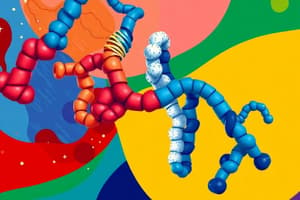Podcast
Questions and Answers
Which level of protein structure is determined by the sequence of amino acids in the polypeptide chain?
Which level of protein structure is determined by the sequence of amino acids in the polypeptide chain?
- Quaternary structure
- Primary structure (correct)
- Secondary structure
- Tertiary structure
Which type of fibrous protein is formed by the arrangement of protein chains into fibres?
Which type of fibrous protein is formed by the arrangement of protein chains into fibres?
- Triple helix
- Coiled-coil
- Collagen (correct)
- β-sheets
What is the primary structure of α-keratin characterized by?
What is the primary structure of α-keratin characterized by?
- Antiparallel β-sheets
- Triple helix structure
- Glycine-rich repeat (correct)
- Coiled-coil structure
How do the β-sheets in fibroin interact with each other?
How do the β-sheets in fibroin interact with each other?
What is the most abundant vertebrate protein?
What is the most abundant vertebrate protein?
Which amino acid is frequently found in the repeating tripeptide sequence of collagen?
Which amino acid is frequently found in the repeating tripeptide sequence of collagen?
How do the polypeptide chains in collagen form inter-chain bonds?
How do the polypeptide chains in collagen form inter-chain bonds?
Which type of bond is responsible for the formation of tertiary structure in proteins?
Which type of bond is responsible for the formation of tertiary structure in proteins?
What is the function of disulphide bridges in proteins?
What is the function of disulphide bridges in proteins?
How are alpha-helices usually represented in diagrammatic representations of tertiary structure?
How are alpha-helices usually represented in diagrammatic representations of tertiary structure?
What is the primary role of non-covalent bonds in tertiary structure formation?
What is the primary role of non-covalent bonds in tertiary structure formation?
Which level of protein structure is responsible for the association of secondary structures into compact domains?
Which level of protein structure is responsible for the association of secondary structures into compact domains?
What is the function of quaternary structure in proteins?
What is the function of quaternary structure in proteins?
What makes proteins more resistant to degradation and denaturation?
What makes proteins more resistant to degradation and denaturation?
What is the primary component shown in diagrammatic representations of tertiary structure?
What is the primary component shown in diagrammatic representations of tertiary structure?
Which type of bond is NOT involved in the formation of tertiary structure in proteins?
Which type of bond is NOT involved in the formation of tertiary structure in proteins?
Quaternary structure refers to the arrangement of protein chains into fibres.
Quaternary structure refers to the arrangement of protein chains into fibres.
Globular proteins are usually involved in structural roles within the cell.
Globular proteins are usually involved in structural roles within the cell.
The primary structure of a protein is determined by the position of disulphide cross-links.
The primary structure of a protein is determined by the position of disulphide cross-links.
Keratin is a fibrous protein that forms strong fibres in skin, bone, teeth, etc.
Keratin is a fibrous protein that forms strong fibres in skin, bone, teeth, etc.
Collagen forms a triple helix structure, with every 4th amino acid passing through the center.
Collagen forms a triple helix structure, with every 4th amino acid passing through the center.
True or false: Tertiary structure refers to the association of secondary structures into compact domains.
True or false: Tertiary structure refers to the association of secondary structures into compact domains.
True or false: covalent bonds, hydrogen bonds and van der Waals forces, play a crucial role in the correct formation of tertiary structure.
True or false: covalent bonds, hydrogen bonds and van der Waals forces, play a crucial role in the correct formation of tertiary structure.
True or false: Disulphide bridges are covalent bonds that can form between the side chains of cysteine residues, making proteins more resistant to degradation and denaturation.
True or false: Disulphide bridges are covalent bonds that can form between the side chains of cysteine residues, making proteins more resistant to degradation and denaturation.
True or false: Diagrammatic representations of tertiary structure usually only show the polypeptide backbone, with alpha-helices represented as spirals or cylinders, and beta-strands represented as arrows.
True or false: Diagrammatic representations of tertiary structure usually only show the polypeptide backbone, with alpha-helices represented as spirals or cylinders, and beta-strands represented as arrows.
True or false: Quaternary structure refers to proteins that are formed from more than one polypeptide chain.
True or false: Quaternary structure refers to proteins that are formed from more than one polypeptide chain.
Flashcards are hidden until you start studying



